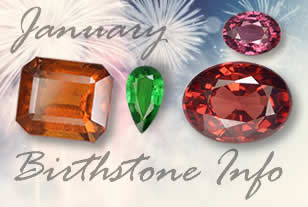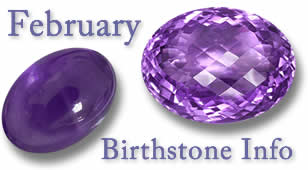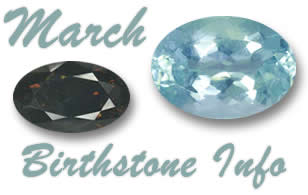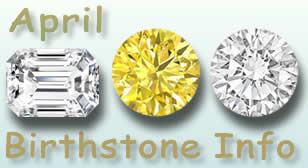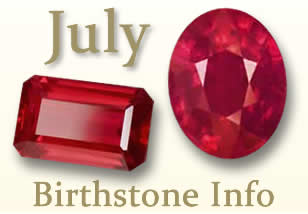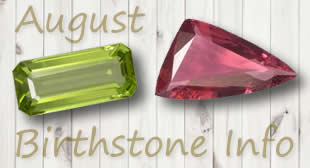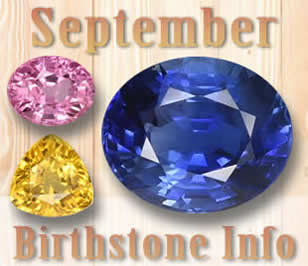What can I find in this article?
- What is the color of the June birthstones?
- Etymology, History and Lore of the June Birthstone
- Spiritual Meaning of the June Birthstones
- Healing Properties of the June Birthstones
- Durability of the June Birthstones
- Cleaning and Caring for June Birthstones
- Buying June Birthstones
- Are there any secondary June birthstones?
- Final Thoughts
The June Birthstones - Pearl and Moonstone
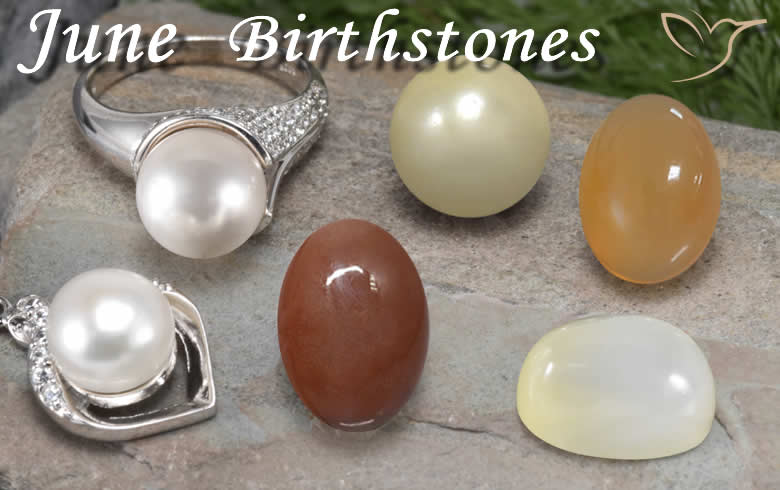
A pearl is produced in a living bivalve, shelled mollusk, such as an oyster (the most common) or an abalone clam. These hard, round, glistening objects appear inside the soft tissue of a mollusk due to the insertion or introduction of some kind of irritant. Under natural, spontaneous conditions, that could be a grain of sand, a microscopic intruder, or a parasite; while the production of cultured pearls begins with a tissue implant, typically a piece of mantle from a "donor shell".
Regardless of the type of irritant, the process is the same: A pearl sac is formed from external mantle tissue cells, then calcium carbonate (the material that composes both the shell and the pearl) and conchiolin (a protein involved in shell formation) is secreted to cover the irritant. This secretion process is repeated many times, thus producing a pearl.
The finest quality of pearls have been considered as gemstones for over 6,000 years.
Almost all species of shelled mollusks are capable of producing pearls, yet the majority of pearls on the market today are a product of cultivation under artificial conditions. There are four major types of cultured pearls: Akoya, South Sea, Tahitian, and Freshwater. Natural pearls are extremely rare and, therefore, incredibly expensive relative to cultivated pearls, which are comparatively lower in price.
Whether cultivated or sourced in the wild, gem-quality pearls are typically iridescent (or nacreous) due to the nacre that makes up the inner layer of the shell, also known as "mother of pearl". All pearls are evaluated based on their luster, nacre thickness, shape, surface quality, color, and size.
This June birthstone is relatively quite soft; so, it is most commonly used in the iconic string-of-pearls necklace, or earrings, where they are unlikely to become scratched. In addition to its place as the June birthstone, pearl is also customarily given as a 3rd or 30th wedding anniversary present. Moreover, with moonstone, pearl shares astrological association with the Moon.
Moonstone is the popular name given to a gem-quality variety of feldspar. In its most common form (the orthoclase species), it is composed of alternating layers of orthoclase and albite, giving it the appearance of having a soft glow of light, just below the surface of a polished gemstone, that seems to roll across the gem's surface as you change the viewing angle. This effect, reminiscent of moonshine (hence the name) is called adularescence, and accounts for moonstone's magic and mystery throughout the ages.
A relatively softer gem, this June birthstone is, nonetheless, used extensively in jewelry and is likely the most recognizable form of feldspar. The cabochon is the most common cut for moonstone, as it best displays the adularescence, as well as the occasional "cat's eye" effect; however, it is also very common to find faceted moonstone.
While moonstone is generally considered one of the June birthstones, it is also, appropriately, the gem for Earth's satellite, the Moon, in astrology.
Color of Pearl
Pearls occur in a wide array of color; the most familiar of these are white and cream (light yellowish brown), followed by black, grey, and silver, which are also very popular hues. This June birthstone can be found in warm colors, such as yellow, orange and pink; or in cool hues, such as blue, green, and violet.
The actual color profile of pearl is composed of a main color, called the "bodycolor", which is then modified by translucent overtones, commonly pink (rose), blue, green, or purple. Many pearls exhibit the phenomenon known as "orient", which is a shimmer of iridescent rainbow colors visible on or just below the pearl's surface. This effect occurs when the nacre is particularly thick.
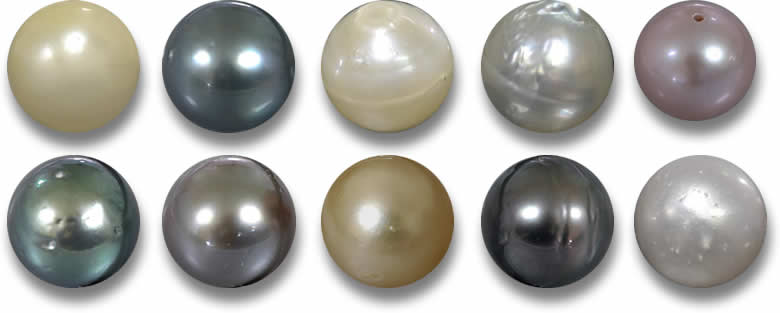
Color of Moonstone
Moonstone's are typically opaque to semitransparent, colorless, and exhibit a bluish white sheen (adularescence). They may also have a bodycolor that can be green, yellow to brown, or grey to black; however, the most highly prized moonstones are colorless, semitransparent to nearly transparent, exhibit the bluish white adularescence, and be free of inclusions.
In addition to the adularescence that gave moonstone its name, these June birthstones may exhibit chatoyancy (cat's eye effect), or asterism (star effect). Moonstones are typically cut into a cabochon to highlight these effects and maximize the field of view of the adularescence. Moonstone's value drops as the adularescence's field of view is limited.
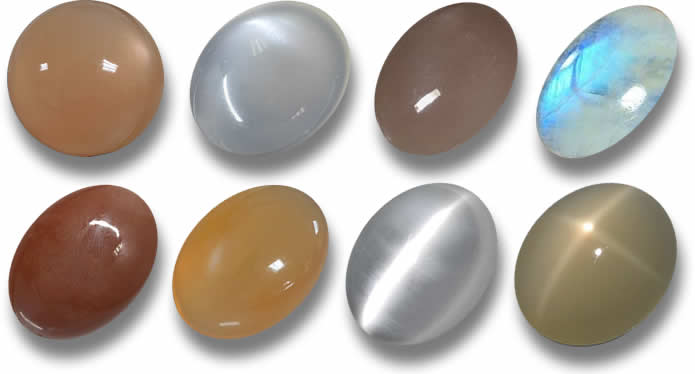
Pearl's Etymology, History and Lore
Pearl's Etymology
The etymology of pearl is not as clear-cut as that of moonstone. There are three plausible explanations for how this word ended up in Middle English as perle:
- it came from the Latin perna, referring to the shape of a bivalve mollusk resembling a leg of lamb.
- it's derived from the Latin perla, meaning "little bag"
- it was taken from the Latin roots for "pear", perhaps in a comment on the similar shapes of pears and pearls.
Pearling
Pearl hunting is well-documented as far back as the 6th century BCE, when it was mentioned in the Mahamavsa, an epic poem chronicling the history of Sri Lanka. At that time, pearls were already a thriving industry in the Port of Oruwella in the Gulf of Mannar in Sri Lanka. Pliny the Elder, Rome's renowned naturalist and philosopher, proclaimed this region the most productive pearl fishery in the world. And the Romans knew what they were talking about; they developed such a great appreciation for pearl, that they only allowed it to be worn by citizens of high rank and status.
For centuries, divers retrieved seawater pearls from the Gulf of Mannar, the Indian Ocean, the Red Sea, and the Persian Gulf. During the Han Dynasty (206 BCE to 220 CE), the Chinese began to hunt extensively for pearl in the South China Sea.
When 16th Spanish conquistadors arrived in the Americas, they found indigenous peoples adorned with pearls and began to trade for them. One discovery in particular, around the islands of Cubagua and Margarita, just off the coast of Venezuala, introduced the world to a truly unique yellowish pearl, known today as Margarita pearls. The most famous of these was the 1250 grains (81 grams) La Peregrina Pearl, which was given to King Philip II of Spain, who then gifted it to his wife, Mary I of England.
This was not the only famous pearl in the England, though. By this time the British Isles had been very well known as a source of exceptional freshwater pearls. In an offering to Venus Genetrix, goddess of motherhood and domesticity, Julius Caesar (1st century Roman emperor) made a breastplate of pearls fished from England for the goddess' statue. According to myth, Venus Genetrix cherished pearl; so, too, did Caesar, who reportedly gave one worth 6 million sesterces to his lover Servilia. To put this in perspective, a Roman soldier was paid 900 sesterces per year!
A legend about Cleopatra tells of her bid to impress Mark Antony, and the Roman Empire he represented, with Egypt's immense wealth and a boast that she could serve the most expensive lunch in history. To do so, the Queen of Egypt promptly plucked a pearl (worth about $14 million) from a pair of earrings, crushed it, dissolved it in a goblet of vinegar, and gulped it down. It is reported that Antony declined to drink the pearl's pair, and conceded that Egypt was a truly great empire.
Pearl Farming
Japan spearheaded pearl cultivation in the early 20th century with the South Sea pearl oyster, though production was interrupted by WWII. In the 1950s, Japan recommenced pearl farming in areas off the northwestern Australian coast and areas around Burma.
In 2010, China overtook Japan in production of Akoya pearls, and in 2013, Indonesian pearl accounted for 43% of the market's supply of South Sea pearls. Australia, the Philippines, Myanmar, and Malaysia also produce significant amounts of seawater pearls.
As British river mussels became increasingly endangered, the U.K. resolved to ban pearling in 1998. Freshwater pearl was farmed almost exclusively in Japan, in the area around Kyoto, until pollution halted production in the 1970s. Since then, Japanese companies began investing their operations in the area around Shanghai, China, and are now producing over 1,500 metric tons of pearl per year.
Moonstone's Etymology, History and Lore
Moonstone's Etymology
The etymology of moonstone seems fairly self-explanatory: the name came from the lustrous, "moonlight" sheen of the adularescence.
Moonstone is also known as selenite, a name derived from the Greek selene, meaning "moon".
It was known in Hindi as chandrakant, meaning "beloved of the Moon", and derived from the Sanskrit chanda (moon) and kanta (beloved).
History and Lore of Moonstone
This popular June birthstone has been used for millennia in the deification of the Moon, as well as connecting those of us on Earth to that celestial body that orbits our planet, influencing the tides, and some say our emotions. Throughout various periods and civilizations, moonstone has always been thought of as embodying the same characteristics attributed to the physical Moon - love, romance, femininity, intuition, dreams, and emotions.
The ancient Hindus kept moonstone as a sacred gem, believing that it was composed of moonbeams, and that such a gemstone was embedded in the forehead of Ganesh, the elephant-headed god of the Moon. According to myth, placing a moonstone in the mouth during a full moon granted one the gift of prophecy and clairvoyance. Moonstone is still held sacred in modern India; sellers will not display a moonstone for sale outside unless it is placed on a yellow (a sacred color) cloth.
Both ancient Greeks and Romans were fascinated by moonstone; they, too, believed that it was formed from moonlight and linked it to their respective Moon deities. The Romans began using moonstone in their jewelry as early as 100 CE, and in the Orient, where moonstone was thought to contain a living spirit, it was used for adornments and good luck charms even further back than that.
Often referred to as the "Traveler's Stone", moonstone was thought to protect one on a journey, especially at night, such as the physical Moon was relied upon to do before electricity. By the time moonstone became popular in Europe, there was a growing legend that moonstone could reconcile estranged lovers.
This June birthstone gained popularity in the U.S. during the Art Nouveau period of the 1920s, particularly among men, who wore moonstone in their tie pins and clips, as well as cufflinks.
In 1970, to commemorate the Moon landings, Florida adopted the moonstone as its state gemstone.
Moonstone is mined extensively in Armenia, Australia, the Austrian Alps, Mexico, Madagascar, Myanmar, Norway, Poland, India, Sri Lanka, and the U.S. Historically, Myanmar produced the finest quality moonstone; however, it seems that supply has been completely mined out, although one can find them in the markets today. Moreover, moonstone is most popular in Germany and the Scandinavian countries, where it is a preferred June birthstone.
What is the spiritual meaning of pearl?
Pearls are considered to be gems of nourishment and nurturing, as their creation is a result of the mollusk's self-nurturing. Indeed, pearls have been used for centuries for their healing properties, especially in traditional Asian medicine.
As spiritual objects, pearls represent a calm and centered being, focused on faith, loyalty, integrity, and purity. They are also potent symbols of femininity that help women discover their "inner goddess" and harness the powerful feminine energy of nature and the universe.
For many people, the most outstanding spiritual attribute of this June birthstone is its connection to purity and loyalty. As a result, more brides are choosing to wear pearls on their wedding day. Not only do they make a stunning complement to any style of dress or theme, pearls speak of the virtues of those who wear them.
What is the spiritual meaning of moonstone?
Moonstone represents a sacred feminine energy - the yin that restores balance and promotes peace and calm. This June birthstone is also seen as an embodiment of the Moon's energy, symbolic of Mother Moon herself. As a stone of love and eroticism, moonstone is often considered the ultimate fertility crystal.
Evocative of deep healing waters, or the guiding light of a full moon, moonstone's high energy rays envelope it in a shimmering white aura that conveys protection and encouragement.
Some may consider the number 13 unlucky, but not those who choose to give moonstone to commemorate their 13th wedding anniversary. This gem will bless the event with its protective lunar energy.
What are the healing properties of pearl?
While most of us think of pearls as ornaments, there is a centuries-long tradition of grinding them into a powder for their curative properties. There is no doubt that Cleopatra would have been aware of this practice during her stunt with Mark Antony.
Use of pearl powder in cosmetics and medicines can be traced back to 4th century BCE China, during the Yan dynasty. Nearly a thousand years later, Ming dynasty medical texts record the use of pearl powder-based medicines to heal skin and promote new skin growth, release toxins, remove skin damage from the sun and age spots.
Ancient India's Ayurvedic medical system prescribed the June birthstone powder to promote overall health and strength, and often used it as an ingredient in love potions. The scientists of medieval Europe investigated pearl powder and proclaimed its effectiveness in the treatment of an array of conditions. Most notably among these characters was the 16th century English philosopher and statesman, Francis Bacon, who believed ingesting pearls could prolong life, and perhaps he was right. Living until the age of 65, Bacon left the world at the high end of life expectancy for the 1600s in Europe.
With the scientific method clearly defined and in practice by the 21st century, researchers began investigating the healing properties of pearl under controlled laboratory conditions. What they have found since then is astounding:
- Increased lifespans through stimulating the production of various antioxidants and biochemicals that increase longevity and overall wellness
- Skin health and bone regeneration promoted by the nacre, which regenerates the cells that form new skin, collagen, and bone tissue
- Calming and relaxation from the calcium that elevates GABA (a calming neurotransmitter) levels in the brain
What are the healing properties of moonstone?
Much like the Moon does for the Earth, moonstone helps one regulate the body's biorhythms and attune to nature's energy cycles. This June birthstone is highly effective in caring for the female reproductive system by enhancing fertility, soothing during pregnancy, alleviating menstrual and menopausal discomfort, balancing the hormonal system, and preventing fluid retention.
Moonstone has been known to be effective in the treatment of degenerative conditions of the eyes, hair, skin, and fleshy organs of the body. It has also been used to cure insomnia and encourage pleasant dreams. Moreover, this June birthstone may enhance the absorption of nutrients, eliminate toxins, and treat disorders of the digestive and excretory systems.
The white auric energy of moonstone links it to the Crown Chakra, our spiritual center, and encourages a personal identification with the Infinite, oneness with the universe, peace, and wisdom. Feminine in nature, the moonstone stimulates the intuitive side of the mind. When women wear it, moonstone uncovers their feminine power and clairvoyance; in men, it stimulates the right side of their brain, and encourages nonlinear thinking and emotional balance.

The concept of gemstone durability is comprised of three factors: hardness (resistance to scratching), toughness (resistance to chipping, cracking and breakage), and stability (resistance to chemicals, high temperatures, and light).
What is the durability of pearl?
Pearl's hardness is ranked quite low at 2.5 - 4.5 on the Mohs Hardness Scale - which means that it is very easily scratched or scraped by harder materials (greater than 4.5). But don't let this discourage you; pearl jewelry can be a lasting treasure, if cared for properly.
See our article on the Mohs Hardness Scale here
Pearl's toughness is generally rated as quite good, although aging, dehydration, and excessive bleaching during initial processing can make some pearls more fragile and prone to chips, fractures, and breakage.
High heat from intense light or a jeweler's torch can burn pearls, or cause discoloration, dehydrations, and cracks. Chemicals from hairspray, perfume, and cosmetics, as well as perspiration, can damage pearls and should be avoided.
The bottom line is that pearls can be set in daily wear, June birthstone jewelry, although appropriate settings and styles should be chosen to protect pearls from shock and damage.
What is the durability of moonstone?
Moonstone's hardness is considerably higher than pearl's; at Mohs 6 - 6.5, this June birthstone can mingle with opals, jade, some garnets and turquoise without worry. Yet, it is still lower than quartz, an inescapable mineral that invisibly settles on jewelry and is often wiped away, unknowingly causing scratches.
Despite its hardness, moonstone has poor toughness, due to two cleavage directions, a quality it shares with other species of feldspar. As a result, designers tend to set this June birthstone in pendants, earrings and brooches, rather than rings, to keep them out of harm's way. Don't let that stop you from a June birthstone ring, though; just make sure to use a setting with enough protective metal around the piece, and you will be fine.
Lastly, keep moonstone away from high heat or sudden temperature changes; these conditions can cause it to crack. Furthermore, hydrofluoric acid, a chemical found in rust stain and water spot removers, will damage moonstone's surface.
How can I clean pearl or moonstone?
The good news is that cleaning both June birthstones is incredibly easy. Warm soapy water is the only safe method for these gemstones; steam and ultrasonic cleaners should never be used to clean either pearl or moonstone. While you may use a soft brush for a deep clean, it may be prudent to avoid scrubbing pearl, due to its softness. Also, if your pearls are strung, make sure the string is completely dry before wearing them.
It is always a safe and recommended practice to remove all jewelry before physical activity, or occasions where you may encounter conditions that could harm your gemstones or their jewelry settings.
How should I store my pearl and moonstone gems and jewelry?
Professionals always recommend separating gemstones of different hardness with a fabric-lined jewelry box that has dedicated compartments to accommodate this categorization. If space is an issue, you may use jewelry bags, or acid free paper envelopes (aka "diamond papers") arranged in a parcel paper organizer.
However you choose to store your gemstones, do it in a cool and dry place, away from intense light and the possibility of bumps and knocks.
How much do pearls cost?
The abundant supply of gem-quality cultured pearls means you get a great price. Even at the high end of the price scale, single pearls cost no more than $300. Take, for instance, a cultured, 13 carat golden South Sea pearl, sized about 12 mm, for just $270.
Grey and silver pearls are an alluring alternative to the lighter hues. Consider a cultured, 12 carat, baroque shape, dark grey South Sea pearl, sized 13 mm, available for $130. Or try a pair, ideal for earrings; two cultured, 8.3 carat, spherical, opaque, dark grey South Sea pearls, sized 10 mm each, can make that June birthstone gift happen for only $170.
If you're interested in creating a pearl necklace or bracelet to say "happy birthday," 4-piece lots of cultured, 3 carat, drilled sphere, opaque, light pink freshwater Chinese pearls, sized 7.6 mm each, can be found for just under $70.
If the birthday girl is lucky enough to get natural pearls, expect to pay anywhere from $1,000 to $100,000 for a strand of these rare beauties.
How much do moonstones cost?
Moonstones are available at great prices, and often come in singles and pairs of cabochons, or 10 and 20-piece lots of faceted shapes. A 7 carat, round cabochon, light yellow moonstone, sized 11 mm, is perfect for a June birthstone ring and only costs about $75. Or how about a pair of 3 carat, round cabochon, warm white moonstones, sized about 9 mm, and perfect for earrings - only $60!
Even though many of the moonstones on the market are moderately priced, it is possible to splash out on something high-end. For example a 5 carat blue moonstone of the finest quality, is just under $700. What an incredibly stunning and unforgettable June birthday gift that would make!
In the past, before the 1912 Jewelers of America birthstone chart, cat's eye, turquoise, and agate were considered June birthstones. Today, alexandrite is included with pearl and moonstone for June birthstone options in the U.S.
Alexandrite is an extremely rare color change variety of chrysoberyl. It is said that the stone was named after the Russian tsar, Alexander II (1818 - 1881), When it was first discovered in 1834, it was initially thought to be an emerald because it was discovered in emerald mines located in Russia's Ural region. Inevitably, the red and green color change stone was to be declared the official gemstone of Imperial Russia's Tsardom.
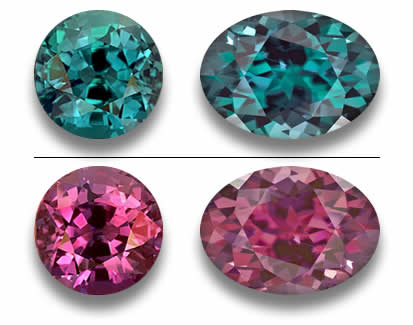
Typically, alexandrite exhibits an emerald-green color in daylight, and raspberry-red under incandescent lighting. Alexandrite can also occur with yellowish and pink colors, and extremely rare specimens can exhibit chatoyancy (cat's eye) effects when cut as cabochon.
Alexandrite is a stone that is associated with discipline and self-control. Many believe that it can promote concentration and strengthen the ability to learn. It also helps in evoking the wearer of the stone to strive for excellence.
In Russian legend, alexandrite's crystal powers were thought to carry good luck, fortune and love to its owner. Alexandrite was believed to bridge the physical and spiritual world. It is a stone associated with the crown chakra and so it carries strong, warm healing energies and is believed to be able to strengthen creativity, imagination, and intuition.
Alexandrites are a hard and durable stone, so they are ideal for any jewelry design such as rings, earrings, pendants, brooches, pins and pendants. Since they are often very small and expensive, they are usually set and utilized as accent stones rather than center stones. They are perfect for creating halo jewelry designs as well as eternity and anniversary bands. For those fortunate enough to celebrate 55 years of marriage, alexandrite is the official gemstone to commemorate this remarkable anniversary.
For most of us, June is the beginning of summer, and we recall those warm nights spent outside in the moonlight, hopefully with a lover, but surely with anticipation for what adventures and experiences lie ahead. The Moon tempers that energy, not by stifling it, but by protecting and nurturing it with rhythm and balance. Pearl and moonstone, as June birthstones, not only physically resemble our satellite, the Moon, they impart all the spiritual energies and virtues we have long attributed to the Moon.
And both June birthstones have their physical vulnerabilities - as we all do - although, under the right conditions, they can be lasting treasures and passed on as heirlooms. Both gemstones are iconic in their own way, and anyone born in June can feel special and unique wearing them.
We stock a large selection of june birthstones right here on our website - Come and have look today!
Disclaimer
Disclaimer GemSelect has been buying and selling gemstones for many years now and in that time we have built up quite a relationship with our customers and suppliers. We are not experts in the meanings and health benefits of gemstones but we have been able to speak with and take advice from people who are.
We are based in Thailand where the belief in spiritual and physical benefits of gemstones, herbs, prayers, pilgrimages, amulets, colors and the stars is common and part of nearly everyone's daily life.
All of our employees have some experience with using gemstones or amulets in order to improve or maintain their physical or emotional health.
The powers of gemstones have been chronicled for 1000s of years and proven time and time again to be effective in improving people lives in many, many ways but we must stress that they are not a replacement for medical treatment.
If you feel unwell or are concerned about your mental health please contact qualified medical help as soon as you can.
In addition we try to research and verify information about the history and efficacy of each gemstone using the internet and various reputable books published by a number of sources.

